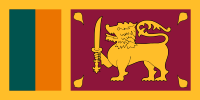Flag of Sri Lanka
| Flag of Sri Lanka | |
|---|---|
 |
|
| Vexillological symbol : |
|
| Aspect ratio: | 1: 2 |
| Officially accepted: | 17th December 1978 |
The flag of Sri Lanka , also known as the "lion flag", was officially adopted on December 17, 1978.
Description and meaning
The national flag of Sri Lanka shows a golden lion against a claret background, which holds a sword ( kastane ) in its right front paw. The golden leaf of a bodhi tree can be seen in each of the four corners of this part of the flag , the tips of which point towards the lion in the center. The lion stands for bravery, while the four leaves symbolize the four Buddhist " heavenly states of abode ", metta (goodness), karuna (compassion), mudita (compassionate joy) and upekkhā (equanimity). In the left part of the flag two vertical stripes of equal size are placed, which are in the colors green (mast side) and saffron and represent the two large minority groups of the state. The saffron-colored stripe stands for the Tamil ethnic group , the green for the Muslim inhabitants of Sri Lanka. The wine-red background represents Sinhalese, the majority of the country's inhabitants. The yellow frame that surrounds the flag and the stripes represent the unity of the country.
history
The lion is a symbol of the majority Sinhalese people , which derives its name from the Sanskrit word for "lion" ( singha ). The right part of today's flag with the golden lion goes back to a flag of the former Kingdom of Kandy , which existed until the annexation by the British in 1815. After the conquest of Kandy, the British fell into their hands, along with other banners, a lion flag. Although the lion was only one of the many regal insignia of the Kandy kings, the lion flag was interpreted by the British as the symbol of the kingdom they had conquered and was finally displayed as a trophy in the Royal Hospital Chelsea .
Against the background of growing Sinhalese nationalism , which relied heavily on the symbolism of the Kandy Kingdom, the lion flag became the national emblem of the Sinhalese in the early 20th century. The lawyer EW Perera , who rediscovered the flag displayed in Chelsea and made it known in two essays published in 1909 and 1916, made a significant contribution to this . Soon the lion flag - ahistorically - was dated back to the time of the mythical progenitor Vijaya 2500 years ago and understood as a "always there" symbol of the Sinhalese.
After gaining independence in 1948, the lion flag became the national flag. The Ceylon parliament decided against the resistance of Tamil politicians, who saw the introduction of a symbol understood as Sinhalese as an expression of the Sinhalese's claim to supremacy, that the lion flag should be hoisted at the independence celebration. The government also set up a committee to determine the final design of the flag. As a result, the two stripes on the left were added in 1950, which were intended to symbolize Tamil and Muslim minorities as a concession. Originally there was a peg in each of the four corners . In 1972 the pegs were replaced by leaves from the bodhi tree. The leaves in the corners were redesigned in 1978 to look more natural.
 ? British Ceylon, 1875 to 1948
? British Ceylon, 1875 to 1948
 ? Flag of Ceylon, 1948 to 1951
? Flag of Ceylon, 1948 to 1951
 ? Flag of Ceylon, 1951 to 1972
? Flag of Ceylon, 1951 to 1972

 ? former naval war flag of Ceylon
? former naval war flag of Ceylon
Other flags of Sri Lanka
See also
Individual evidence
- ↑ Jakob Rösel: The shape and emergence of Sinhalese nationalism, Berlin 1996, pp. 321–323.
- ↑ Rösel 1996, pp. 323-324.
- ↑ Rösel 1996, pp. 324-329.
literature
- Smith / Neubecker: coats of arms and flags of all nations. Munich 1980, ISBN 3-87045-183-1 .
Web links
- Flags of the World - Sri Lanka (English)







